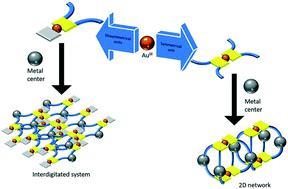当前位置:
X-MOL 学术
›
CrystEngComm
›
论文详情
Our official English website, www.x-mol.net, welcomes your
feedback! (Note: you will need to create a separate account there.)
Heterometallic coordination polymers based on homo- and heteroleptic Au(III) dithiolene complexes
CrystEngComm ( IF 2.6 ) Pub Date : 2020-08-11 , DOI: 10.1039/d0ce01090a Damien Bechu 1, 2, 3, 4, 5 , Alexandru Mihai Petre 1, 2, 3, 4, 5 , Mir Wais Hosseini 1, 2, 3, 4, 5 , Stéphane A. Baudron 1, 2, 3, 4, 5
CrystEngComm ( IF 2.6 ) Pub Date : 2020-08-11 , DOI: 10.1039/d0ce01090a Damien Bechu 1, 2, 3, 4, 5 , Alexandru Mihai Petre 1, 2, 3, 4, 5 , Mir Wais Hosseini 1, 2, 3, 4, 5 , Stéphane A. Baudron 1, 2, 3, 4, 5
Affiliation

|
Two novel hetero- and homoleptic Au(III) complexes based on a dithiolene ligand bearing two 4-thiopyridyl groups have been designed, synthesized and characterized in solution and in the crystalline state. These species have been employed as metalloligands, or metallatectons, for the elaboration of heterometallic coordination polymers upon assembly with M(NCS)2 salts (M = Mn, Co, Cd) and Co(N(CN)2)2 respectively. Upon combination of the neutral heteroleptic complex comprising a cyclometallating benzo[h]quinoline fragment and the mononuclear Mn(NCS)2 and Co(NCS)2 nodes, one-dimensional coordination networks were obtained. They feature pendant heteroleptic complexes that stack centrosymmetrically in the crystalline state leading to an interdigitated system, analogous to what has been reported with the parent EDT-TTF derivative. With Cd(NCS)2, the inorganic moieties form a two-dimensional ruffled layer with bridging thiocyanate anions, while the Au(III) complexes occupy the remaining apical positions of the Cd(II) centers. This leads to a stacking of the heteroleptic species. With the homoleptic complex, a monoanionic analogue of a symmetrical TTF, a two-dimensional coordination network was obtained by combination with Co(N(CN)2)2, featuring one dimensional [Co(N(CN)2)]α chains. These networks have been characterized in the crystalline state by X-ray diffraction and represent, to the best of our knowledge, the first heterometallic coordination polymers based on Au(III) dithiolene complexes and transition metal cations.
中文翻译:

基于均相和杂相Au(III)二硫代烯烃配合物的杂金属配位聚合物
已经设计,合成和表征了两种基于带有两个4-硫代吡啶基的二硫代烯配体的杂合和均化的Au(III)络合物。这些物质已被用作金属配体或金属离子,用于分别与M(NCS)2盐(M = Mn,Co,Cd)和Co(N(CN)2)2组装时加工杂金属配位聚合物。结合了包含环金属化苯并[ h ]喹啉片段和单核Mn(NCS)2和Co(NCS)2的中性杂合剂节点,获得一维协调网络。它们的特征是侧基杂配物复合物,在结晶状态下中心对称地堆叠,形成一个相互交叉的系统,类似于母体EDT-TTF衍生物的报道。与Cd(NCS)2一起,无机部分与桥连的硫氰酸根阴离子形成二维褶皱层,而Au(III)络合物占据了Cd(II)中心的其余顶端位置。这导致杂种的堆积。用均相络合物(对称TTF的单阴离子类似物)与Co(N(CN)2)2结合获得二维配位网络,其特征为一维[Co(N(CN)2)] α链。这些网络已通过X射线衍射表征为结晶状态,据我们所知,代表了第一种基于Au( III)二硫代苯配合物和过渡金属阳离子的杂金属配位聚合物。
更新日期:2020-09-14
中文翻译:

基于均相和杂相Au(III)二硫代烯烃配合物的杂金属配位聚合物
已经设计,合成和表征了两种基于带有两个4-硫代吡啶基的二硫代烯配体的杂合和均化的Au(III)络合物。这些物质已被用作金属配体或金属离子,用于分别与M(NCS)2盐(M = Mn,Co,Cd)和Co(N(CN)2)2组装时加工杂金属配位聚合物。结合了包含环金属化苯并[ h ]喹啉片段和单核Mn(NCS)2和Co(NCS)2的中性杂合剂节点,获得一维协调网络。它们的特征是侧基杂配物复合物,在结晶状态下中心对称地堆叠,形成一个相互交叉的系统,类似于母体EDT-TTF衍生物的报道。与Cd(NCS)2一起,无机部分与桥连的硫氰酸根阴离子形成二维褶皱层,而Au(III)络合物占据了Cd(II)中心的其余顶端位置。这导致杂种的堆积。用均相络合物(对称TTF的单阴离子类似物)与Co(N(CN)2)2结合获得二维配位网络,其特征为一维[Co(N(CN)2)] α链。这些网络已通过X射线衍射表征为结晶状态,据我们所知,代表了第一种基于Au( III)二硫代苯配合物和过渡金属阳离子的杂金属配位聚合物。











































 京公网安备 11010802027423号
京公网安备 11010802027423号